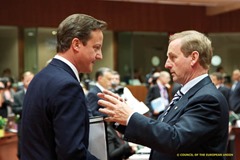UK-Irish joint trade initiatives
 Michael McKernan considers the pros and cons of joined-up trade missions, as part of increasing co-operation between London and Dublin.
Michael McKernan considers the pros and cons of joined-up trade missions, as part of increasing co-operation between London and Dublin.
When Queen Elizabeth II made her state visit to Ireland in 2011, political relations between Ireland and Britain had reached a new high. Against a background of goodwill between the two governments on political matters, it was logical to see if the relationship could be deepened in other areas and, in particular, the economic policy sphere.
In March 2012, David Cameron and Enda Kenny announced a new era of joint working in a 10-year declaration of co-operation which stated the commitment of both countries not only to continue working closely together on Northern Ireland, but also to extend this to other areas. These would include academic research, EU affairs, climate change, international aid and, most importantly, trade. Senior civil servants were charged with giving new impetus to the process of exploring more areas where co-operation could be mutually beneficial.
One of the outworkings of this process was a study report into the question of greater UK-Irish co-operation in trade, which was conducted on behalf of both governments by PA Consulting and Cambridge Econometrics and published in August 2013.
The report highlighted the close ties that already existed between the two economies including the fact that Britain was Ireland’s most important export market, accounting for 16 per cent of Irish industrial products and 20 per cent of Ireland’s exported services. It also estimated that 208,000 Irish jobs were dependent on trade with the UK. The report pointed to many areas where trade co-operation could be enhanced and cited joint trade missions as a good example of ‘practical measures’ that could be taken.
The report was welcomed by both government leaders, including the idea of joint trade missions: something that was already happening between Enterprise Ireland and Invest NI. However, London-Dublin and joint trade promotion was a new concept.
Although the joint statement had recognised that there would continue to be areas of trade where the UK and Ireland would continue to compete with each other, joint trade missions were envisaged particularly where it was considered that “the consumer is too distant to distinguish between the UK and Ireland”. The report acknowledged that this could end up with British ministers promoting the benefits of Ireland overseas and vice versa. It also placed a focus on developing joint trade promotional proposals in the agri-food sector.
However, not everyone has shared the enthusiasm of the two prime ministers. Tánaiste Eamon Gilmore, while welcoming the report, highlighted its limitations. He said: “It’s feasible, it’s limited. I think we have to recognise that there are areas we are going to be competing in.”
On foreign direct investment, the Tánaiste said: “We’ll be looking at the same multi-national companies and we’re going to be competing for that. But there are opportunities, particularly in outward investment where a joint package, Irish and British companies working together, might be successful.”
It is known also that Dublin has a particular reticence about joint trade promotion with the UK in the agri-food sector, where it believes Ireland has a competitive advantage and a better all-round food ‘image’ than Britain. It is understood also that Environment Secretary Owen Paterson believes that the UK should act independently in agri-food too. So there is no doubt that Ireland and Britain have entered a new era of trade co-operation. This is reflected, not least, in the rapid growth of the British-Irish Chamber of Commerce formed only two years ago. Joint trade missions will happen but maybe not as many as originally thought.





